If you’re looking for a restaurant-quality meal that’s easy to prepare, seared tuna is a must-try. Not only is it incredibly flavorful, but it also takes just minutes to cook. In fact, with the right technique, you can achieve that perfect contrast—a crispy, golden-brown crust on the outside and a tender, rare center inside.
Moreover, seared tuna is a healthy, high-protein option that fits well into various diets, from low-carb to Mediterranean. Additionally, it’s packed with omega-3 fatty acids, making it both a nutritious and delicious choice. As a result, this dish has gained popularity worldwide, with chefs and home cooks embracing its versatility.
That being said, achieving the perfect sear requires a few key techniques. Fortunately, this guide will walk you through every step, ensuring your tuna is perfectly cooked. So, whether you’re making it for a quick weekday lunch or an elegant weekend meal, you’re in for a treat!
Why Seared Tuna is a Must-Try Dish?
If you haven’t tried seared tuna yet, you’re definitely missing out. Not only is it a quick and easy dish to prepare, but also it offers a unique combination of flavors and textures. On one hand, the crispy, seasoned crust provides a satisfying crunch. On the other hand, the tender, rare center melts in your mouth, creating an unforgettable experience.
Furthermore, seared tuna is incredibly versatile. For instance, you can serve it over a fresh salad, pair it with rice and vegetables, or enjoy it as a protein-packed addition to a poke bowl. In addition, it complements a wide range of seasonings, from simple salt and pepper to bold Asian-inspired marinades.
More importantly, this dish isn’t just about taste—it’s also a powerhouse of nutrition. Because tuna is rich in omega-3 fatty acids, it supports heart health and brain function. Likewise, it’s packed with lean protein, making it a great option for those looking to maintain a healthy diet.
All things considered, seared tuna is the perfect balance of gourmet and convenience. So, whether you’re cooking for yourself or impressing guests, this dish is a guaranteed hit!
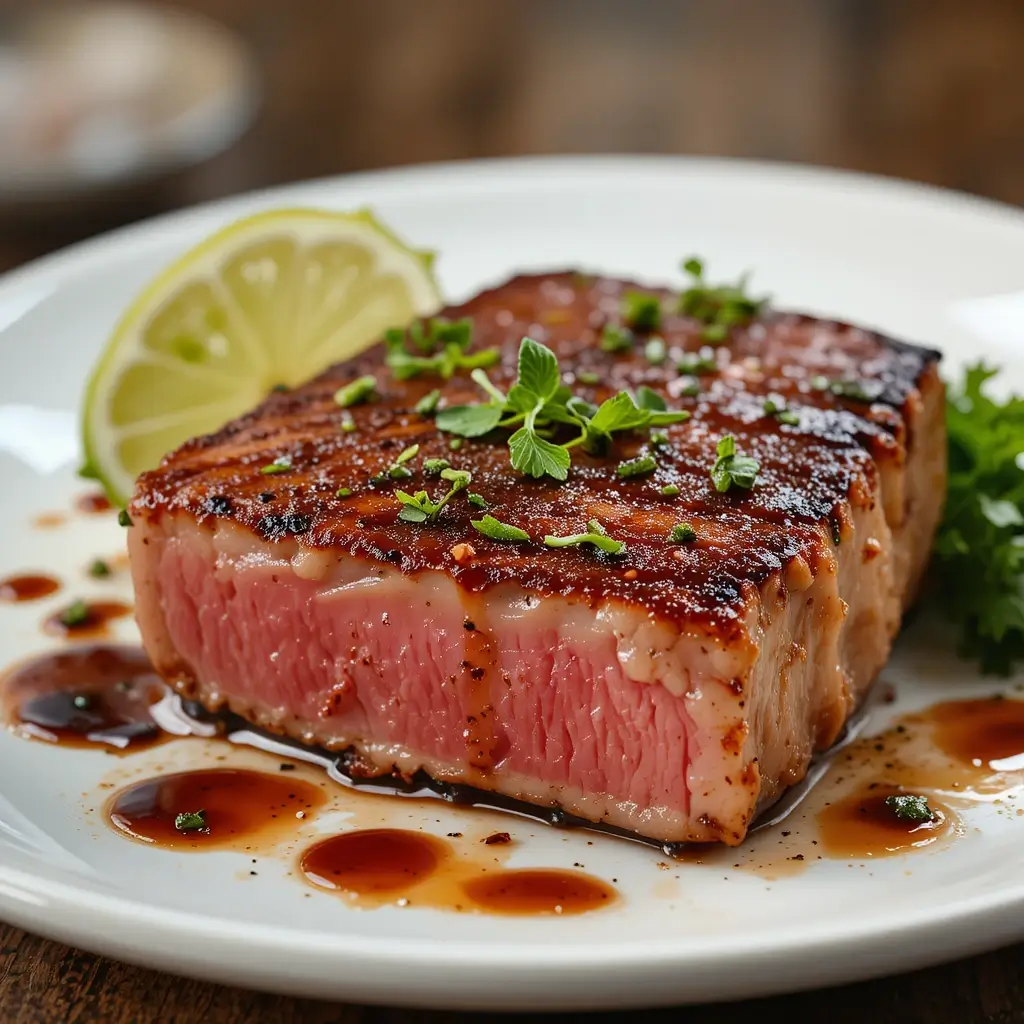
Choosing the Right Tuna for Searing
Selecting the right tuna is essential for achieving the perfect sear. First and foremost, always choose sushi-grade tuna, as it is specifically handled and frozen to be safe for raw consumption. Otherwise, using lower-quality tuna may result in an unpleasant texture and taste.
In terms of variety, Yellowfin (Ahi) and Bluefin tuna are the best options. While Yellowfin is more widely available and has a mild flavor, on the other hand, Bluefin is richer and more buttery, making it a premium choice. Regardless of which you choose, both work well for searing, provided they are fresh.
Additionally, pay close attention to the tuna’s appearance. Ideally, it should be bright red or deep pink, without any brown or gray spots. If the color looks dull or discolored, it’s a sign the fish is not fresh. Moreover, fresh tuna should have a mild ocean scent. If it smells overly fishy, it’s best to avoid it.
Lastly, consider the thickness of your tuna steaks. For the best results, they should be at least 1 to 1.5 inches thick. Otherwise, thinner cuts may overcook too quickly, preventing you from achieving that beautifully rare center.
In short, choosing high-quality, sushi-grade tuna with a fresh scent and vibrant color will ensure a perfectly seared, restaurant-worthy dish.
Essential Ingredients for Perfectly Seared Tuna
To create the perfect seared tuna, you need a few high-quality ingredients. Of course, the star of the dish is sushi-grade tuna steaks, but the right seasonings and oils can take it to the next level.
Main Ingredients for Seared Tuna:
- 2 sushi-grade tuna steaks (about 6 oz each) – After all, the quality of the tuna determines the success of the dish.
- 2 tbsp soy sauce – Not only does this add umami flavor, but also it helps enhance the natural taste of the tuna.
- 1 tbsp sesame oil – Similarly, this oil provides a rich, nutty aroma that complements the tuna beautifully.
- 1 tbsp olive oil – Meanwhile, olive oil ensures a perfect sear and prevents sticking.
- 1 tsp fresh ginger, grated – Because ginger adds a subtle heat and depth of flavor.
- 1 tsp garlic, minced – Likewise, garlic enhances the overall savoriness of the dish.
- ½ tsp black pepper – After all, a touch of spice balances the richness of the tuna.
- 1 tbsp toasted sesame seeds – Not only do they add a delightful crunch, but also they enhance the presentation.
- ½ tsp sea salt – Since salt draws out the natural flavors, a small pinch goes a long way.
- ½ tsp red pepper flakes (optional) – If you prefer a kick, this ingredient adds just the right amount of heat.
For Serving:
- Lemon wedges – Because a squeeze of fresh lemon brightens up the dish.
- Wasabi or sriracha mayo – If you love bold flavors, this is a must-have condiment.
- Mixed greens or avocado slices – In addition, these make the dish feel fresh and balanced.
- Steamed rice or quinoa (optional) – For a heartier meal, these grains serve as the perfect base.
All in all, combining these simple yet flavorful ingredients will give you an irresistible, restaurant-quality seared tuna dish.
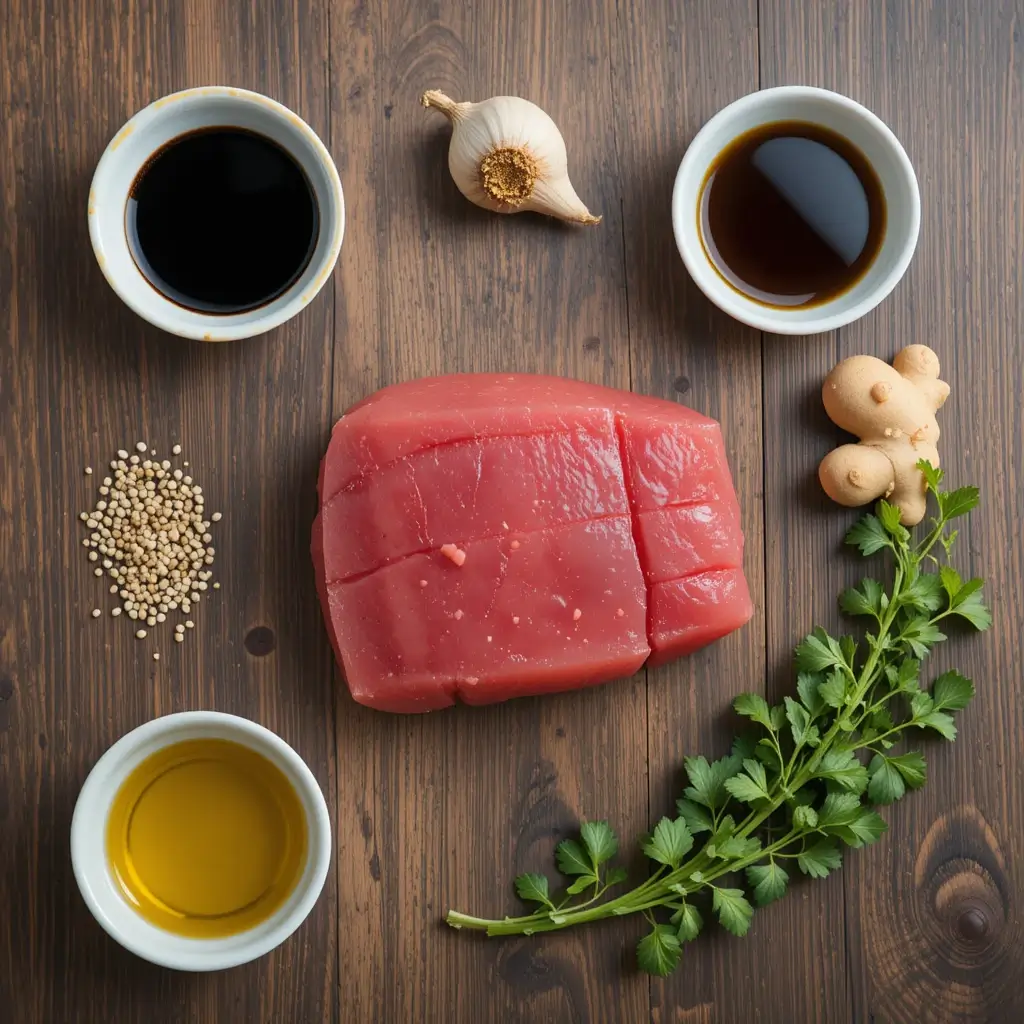
Step-by-Step Guide to Searing Tuna
Searing tuna is a quick and easy process, but following the right steps ensures the best results. By paying attention to the details, you’ll achieve a beautiful crust while keeping the center rare and tender. Here’s how to do it:
1: Prepare the Marinade
First of all, start by making a simple yet flavorful marinade. In a small bowl, whisk together soy sauce, sesame oil, olive oil, garlic, and ginger. Not only does this enhance the tuna’s natural flavors, but also it helps create a delicious crust when searing. Place the tuna steaks in the marinade and let them sit for 10-15 minutes. Meanwhile, you can prepare the pan for searing.
2: Preheat the Pan
While the tuna marinates, heat a cast-iron skillet or nonstick pan over high heat. Because tuna cooks so quickly, you need a very hot pan to get that golden crust. Add a drizzle of olive oil, spreading it evenly to prevent sticking. At the same time, make sure your kitchen is well-ventilated, as high heat may create some smoke.
3: Season and Sear the Tuna
Once the pan is hot, remove the tuna from the marinade and pat it dry with a paper towel. This is important because too much moisture can prevent a proper sear. Next, season the tuna with sea salt, black pepper, and toasted sesame seeds, pressing the seasoning lightly onto the surface.
Carefully place the tuna steaks into the pan. For the best results, sear each side for 45-60 seconds, depending on how rare you prefer it. On one hand, if you like a deep crust, press the tuna gently against the pan. On the other hand, if you prefer a lighter sear, reduce the time slightly.
4: Rest and Slice
Once seared to perfection, remove the tuna from the heat and place it on a cutting board. At this point, allow it to rest for about 5 minutes. As a result, the juices will redistribute, keeping the tuna moist and flavorful.
Using a very sharp knife, slice the tuna against the grain into ¼-inch thick pieces. That way, you’ll get clean, beautiful slices with the perfect texture.
5: Serve and Enjoy
Finally, arrange the sliced tuna on a plate and garnish with lemon wedges, wasabi, or a drizzle of soy sauce. For an extra touch, serve it with steamed rice, a fresh salad, or avocado slices.
In short, mastering the art of seared tuna is simple with these steps. So, why not try it today? You’ll love the restaurant-quality results right from your own kitchen!
Expert Tips for the Best Seared Tuna
Searing tuna might seem simple, but in reality, small details can make a big difference. For that reason, following a few expert techniques will help you achieve a perfectly crisp crust while keeping the inside tender and flavorful. Here are some key tips to ensure success:
Use a Super-Hot Pan
First and foremost, a hot pan is essential for a proper sear. Because tuna cooks so quickly, you need high heat to create a golden crust without overcooking the inside. In other words, preheat your skillet for at least 2-3 minutes before adding the tuna. Otherwise, the fish will cook unevenly and may not develop a crispy exterior.
Pat the Tuna Dry Before Searing
Before placing the tuna in the pan, always pat it dry with a paper towel. This is important because excess moisture can prevent proper browning. As a result, your tuna might steam rather than sear, leaving you with a less flavorful crust.
Don’t Over-Marinate
While marinating adds great flavor, it’s best to keep it short—10-15 minutes is ideal. If you marinate it for too long, the acids in the marinade can break down the delicate texture of the tuna, making it mushy. Therefore, a quick soak is enough to enhance the taste without affecting the texture.
Use the Right Oil
Because searing requires high heat, choosing the right oil is crucial. For best results, use sesame oil, avocado oil, or grapeseed oil, as these have high smoke points. On the other hand, butter or extra virgin olive oil may burn too quickly, creating an unpleasant flavor.
Let the Tuna Rest Before Slicing
Once the tuna is seared, let it rest for about 5 minutes before cutting. This is because resting allows the juices to redistribute, ensuring a moist and flavorful bite. Otherwise, slicing too soon may cause the juices to run out, making the fish drier.
Use a Sharp Knife for Slicing
Since seared tuna is delicate, a sharp knife is essential for clean, even slices. Instead of using a serrated knife, opt for a long, sharp chef’s knife or sashimi knife. As a result, you’ll get beautifully thin slices without tearing the tuna.
Sear for the Right Amount of Time
Generally speaking, tuna should be seared for 45-60 seconds per side. However, if you prefer a deeper crust, you can press the fish slightly against the pan and extend the searing time to 90 seconds per side. Just be careful, as overcooking will take away the signature rare, buttery center.
Season Right Before Cooking
Unlike other proteins, tuna doesn’t need to be seasoned long before cooking. Instead, sprinkle sea salt, black pepper, and sesame seeds just before placing it in the pan. Otherwise, the salt can draw out moisture, which may affect the texture of the crust.
In short, these simple but effective techniques will help you create a perfectly seared tuna steak every time. So, whether you’re cooking for yourself or impressing guests, these expert tips will elevate your dish to restaurant-quality levels!

Tasty Variations to Try
Seared tuna is incredibly versatile, which means you can experiment with different flavors and styles to suit your taste. Whether you prefer a spicy kick, an Asian-inspired twist, or a Mediterranean flair, there are endless ways to customize this dish. Here are some delicious variations to try:
Spicy Seared Tuna
If you love bold flavors, this variation is for you. Simply add ½ teaspoon of sriracha or a dash of cayenne pepper to the marinade for extra heat. Additionally, you can serve the tuna with a spicy mayo made from mayo, sriracha, and a squeeze of lime. As a result, you’ll get a fiery and flavorful dish with a perfect balance of heat and creaminess.
Asian-Inspired Seared Tuna
For an authentic Japanese twist, serve your seared tuna with ponzu sauce, pickled ginger, and wasabi. Instead of using traditional black pepper, try seasoning the tuna with white pepper and a touch of miso paste in the marinade. Furthermore, you can sprinkle crushed nori or furikake on top for added umami.
Mediterranean-Style Seared Tuna
If you prefer fresh and vibrant flavors, try this Mediterranean version. First, swap out the sesame oil for extra virgin olive oil and add lemon zest and dried oregano to the seasoning. Next, serve the tuna over a bed of arugula, cherry tomatoes, olives, and feta cheese. Finally, drizzle with a light balsamic glaze or lemon vinaigrette for a bright, refreshing touch.
Poke Bowl-Style Seared Tuna
For a fun and colorful dish, turn your seared tuna into a poke bowl! To do this, dice the seared tuna into small cubes and serve it over sushi rice or quinoa. Then, top it with avocado slices, edamame, cucumber, and shredded carrots. For added flavor, drizzle with a spicy sesame dressing or soy-ginger sauce. As a result, you’ll have a nutritious, filling, and visually stunning meal.
Citrus-Glazed Seared Tuna
If you enjoy sweet and tangy flavors, try a citrus-glazed version. Before searing, coat the tuna lightly with a mixture of orange juice, honey, and a touch of soy sauce. Meanwhile, reduce the remaining glaze in a pan until slightly thickened. Once the tuna is cooked, drizzle the glaze over the slices and serve with a side of grilled asparagus or wild rice.
All in all, seared tuna is a dish that welcomes creativity. So, feel free to mix and match flavors based on your preferences. No matter which variation you choose, each one brings a unique and delicious twist to this incredible dish!
Perfect Pairings for Seared Tuna
Seared tuna is delicious on its own, but pairing it with the right sides and sauces can take it to a whole new level. Whether you prefer something light and refreshing or a more substantial meal, there are plenty of great options to complement this dish. Some excellent beverage combinations include:
Side Dishes
- Steamed Jasmine Rice – Because of its mild flavor, jasmine rice soaks up any sauce beautifully, making it a perfect base for seared tuna.
- Soba Noodles – If you’re craving an Asian-inspired meal, soba noodles tossed in a light soy-ginger dressing make an excellent choice.
- Grilled Vegetables – For a healthier option, try roasted or grilled zucchini, bell peppers, and asparagus. Not only do they add color to your plate, but also they enhance the overall flavor of the dish.
- Quinoa or Farro – Since these grains are packed with protein and fiber, they provide a nutritious and hearty base for seared tuna.
Sauces & Dips
- Wasabi Aioli – If you love a bit of heat, a creamy wasabi aioli adds just the right amount of spice.
- Ponzu Sauce – For a citrusy kick, this light soy-based sauce enhances the tuna’s natural flavors.
- Spicy Sriracha Mayo – Similarly, a drizzle of sriracha mayo adds a creamy, slightly sweet heat that pairs beautifully with the crispy seared crust.
- Citrus Soy Glaze – Because the acidity in citrus cuts through the richness of the fish, this sauce brings balance to the dish.
- Miso Dressing – For an umami boost, try serving your tuna with a miso-based dressing, which adds depth and a touch of sweetness.
Beverage Pairings
- Chilled White Wine – Since seared tuna has a rich, buttery texture, a crisp white wine like Sauvignon Blanc or Pinot Grigio helps cleanse the palate.
- Japanese Sake – For an authentic touch, a dry sake complements the umami flavors of the dish.
- Light Beer – If you prefer beer, a light lager or wheat beer pairs well without overpowering the flavors.
- Green Tea or Iced Matcha – For a non-alcoholic option, green tea or matcha enhances the delicate flavors of the tuna while providing a refreshing contrast.
All in all, the right pairing can elevate your seared tuna experience. So, whether you’re serving it as a light appetizer or a full meal, choosing the best sides and drinks will enhance every bite!
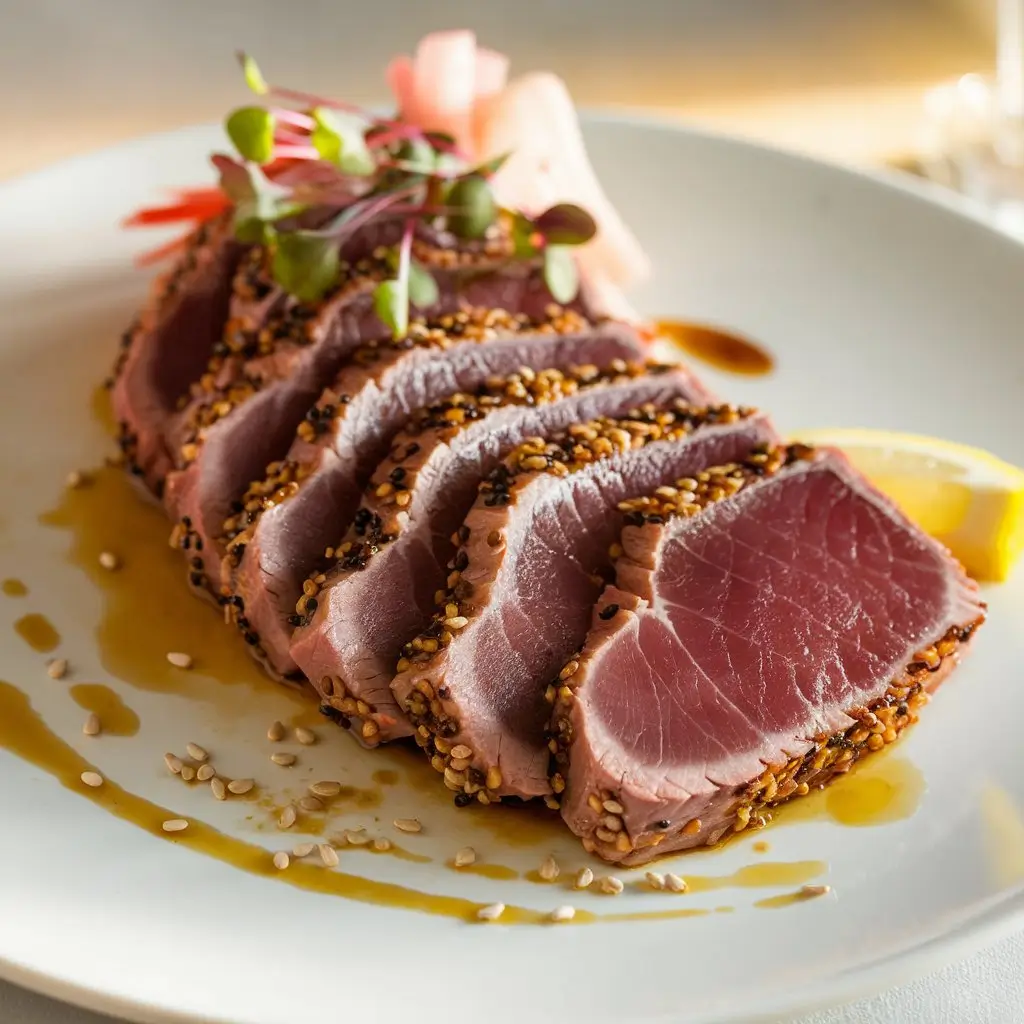
The History of Seared Tuna
Seared tuna may seem like a modern culinary trend, but in reality, its roots trace back centuries to various coastal cultures. Over time, different regions have developed their own unique preparations, making it a beloved dish worldwide.
Origins in Japanese Cuisine
To begin with, Japan has long been known for its mastery of raw and lightly cooked seafood. In fact, the concept of searing tuna is closely linked to tataki, a traditional Japanese cooking method that involves briefly searing fish or meat over a hot flame while keeping the inside rare. Because tuna is a staple in Japanese cuisine, chefs have perfected the art of quick searing, often serving it with ponzu sauce, wasabi, or grated daikon radish.
Influence of Mediterranean and Hawaiian Cultures
Meanwhile, Mediterranean cuisines, particularly in Italy and Spain, have also incorporated seared tuna into their culinary traditions. Since the Mediterranean diet emphasizes fresh seafood and simple seasonings, seared tuna is often paired with olive oil, lemon, and fresh herbs. Additionally, in Spain, tuna is sometimes lightly seared and served as part of tapas, allowing diners to enjoy the rich flavors in small portions.
At the same time, in Hawaii, tuna—especially ahi tuna—plays a crucial role in traditional cuisine. For instance, poke, a dish of marinated raw tuna, shares similarities with seared tuna in its appreciation for fresh, high-quality fish. Eventually, as Hawaiian cuisine gained popularity worldwide, seared tuna became a staple in fusion restaurants and poke bowls.
Seared Tuna in Modern Cuisine
As the culinary world evolved, seared tuna gained popularity in global fine dining and casual restaurants alike. During the late 20th century, chefs began experimenting with cross-cultural flavors, combining Japanese techniques with Mediterranean and Western influences. For example, many restaurants now serve seared tuna with avocado, citrus glazes, or spicy aioli, creating innovative flavor combinations.
More recently, the rise of health-conscious dining has further increased the appeal of seared tuna. Since it is high in protein and omega-3 fatty acids, it has become a favorite choice among fitness enthusiasts and those following low-carb or keto diets. As a result, the dish is now found on menus across the world, from high-end sushi restaurants to casual seafood spots.
Conclusion
All in all, seared tuna has a fascinating history that spans multiple cultures and centuries. From its origins in Japan to its influence in Mediterranean and Hawaiian cuisine, it has evolved into a dish that is both gourmet and approachable. So, whether you enjoy it with soy sauce, citrus glazes, or a simple sprinkle of sea salt, each bite carries a rich culinary heritage worth savoring!
More Lunch Recipes to Try
If you love this Seared Tuna Recipe, you’ll want to try more Lunch recipes that are just as easy and delicious! Here are a few must-try options:
- Classic Homemade Meatloaf Recipe
- The Best Guacamole Recipe
- Alice Springs Chicken Recipe
- The Perfect Shaved Steak
FAQs
Seared tuna is typically both cooked and raw. The outside of the tuna is quickly seared at high heat, giving it a cooked crust, while the inside remains rare or raw. This technique is popular because it enhances the texture and flavor, keeping the interior tender and juicy while adding a savory, slightly charred layer on the outside.
Yes, seared tuna is healthy. It’s rich in lean protein, omega-3 fatty acids, and essential vitamins, supporting heart and brain health. Just enjoy it in moderation due to the potential mercury content.
People sear tuna to create a flavorful, caramelized crust on the outside while keeping the inside tender and rare. This technique enhances both the texture and taste, balancing the rich, buttery flavor of the raw tuna with the slightly crispy, savory exterior. It also locks in moisture and preserves the tuna’s natural nutrients.
Tuna steak is expensive due to its rarity, high demand, costly sustainable fishing methods, and strict handling requirements to maintain freshness and quality.
Absolutely! If you prefer medium or well-done tuna, sear it for 2-3 minutes per side.

Perfectly Seared Tuna Recipe: A Global Delight for Lunch
Equipment
- Cast-iron skillet or nonstick pan
- Small bowl (for marinade)
- Paper towel (for drying tuna)
- Sharp knife (for slicing tuna)
- Cutting Board
Ingredients
- 2 Sushi-grade tuna steaks
- Soy sauce, sesame oil, olive oil
- Fresh ginger, garlic, black pepper
- Sesame seeds, sea salt, red pepper flakes (optional)
- Lemon wedges, wasabi or sriracha mayo for serving
Instructions
- Prepare Marinade: Mix soy sauce, sesame oil, olive oil, ginger, and garlic. Marinate tuna for 10-15 minutes.

- Preheat Pan: Heat a skillet over high heat with a little olive oil.

- Sear Tuna: Pat dry the tuna, and season with salt, pepper, and sesame seeds. Sear for 45-60 seconds on each side.

- Rest & Slice: Rest the tuna for 5 minutes, then slice against the grain.

- Serve: Garnish with lemon, wasabi, or sriracha mayo, and serve with rice, avocado, or greens.

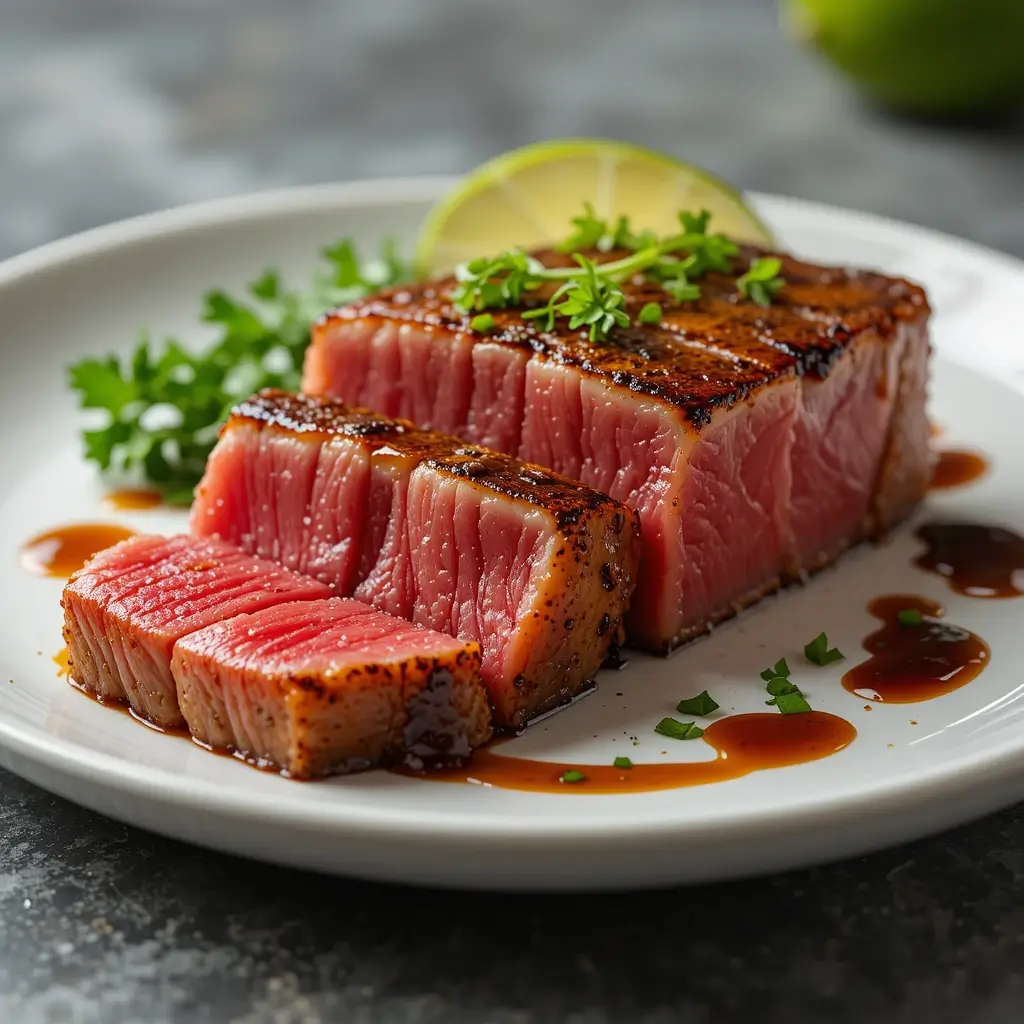
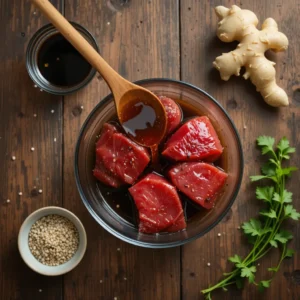

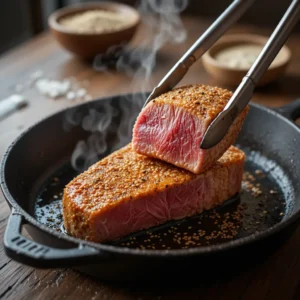
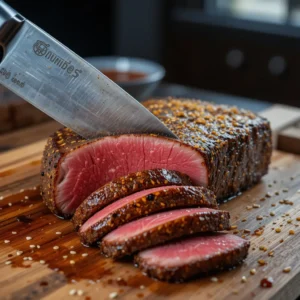
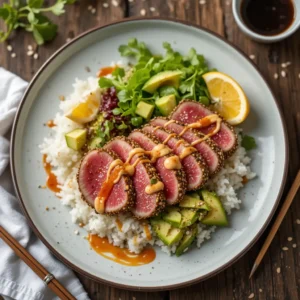
Perfectly seared